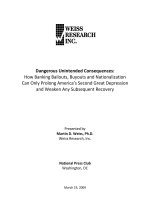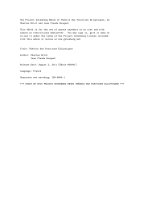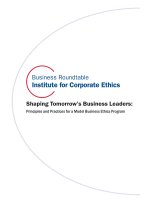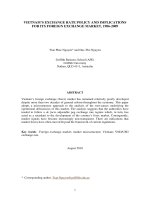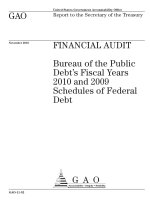China's Superbank: Debt, Oil and Influence - How China Development Bank is Rewriting the Rules of Finance
Bạn đang xem bản rút gọn của tài liệu. Xem và tải ngay bản đầy đủ của tài liệu tại đây (3.87 MB, 226 trang )
China’s Superbank
ffirs 9 October 2012; 18:22:37
Since 1996, Bloomberg Press has published books for financial professionals
as well as books of general interest in investing, economics, current affairs,
and policy affecting investors and business people. Titles are written by well-
known practitioners, BLOOMBERG NEWS
®
reporters and columnists,
and other leading authorities and journalists. Bloomberg Press books have
been translated into more than 20 languages.
For a list of available titles, please visit our Web site at www.wiley.com/
go/bloombergpress.
ffirs 9 October 2012; 18:22:37
China’s Superbank
Debt, Oil and Influence—
How China Development
Bank Is Rewriting the
Rules of Finance
Henry Sanderson
Michael Forsythe
ffirs 9 October 2012; 18:22:37
Copyright ª 2013 by Henry Sanderson, Michael Forsythe.
Published by John Wiley & Sons Singapore Pte. Ltd.
1 Fusionopolis Walk, #07-01, Solaris South Tower, Singapore 138628
All rights reserved.
No part of this publication may be reproduced, stored in a retrieval system, or transmitted
in any form or by any means, electronic, mechanical, photocopying, recording, scanning,
or otherwise, except as expressly permitted by law, without either the prior written
permission of the Publisher, or authorization through payment of the appropriate photocopy
fee to the Copyright Clearance Center. Requests for permission should be addressed to the
Publisher, John Wiley & Sons Singapore Pte. Ltd., 1 Fusionopolis Walk, #07-01, Solaris
South Tower, Singapore 138628, tel: 65–6643–8000, fax: 65–6643–8008, e-mail:
Limit of Liability/Disclaimer of Warranty: While the publisher and author have used their
best efforts in preparing this book, they make no representations or warranties with respect to
the accuracy or completeness of the contents of this book and specifically disclaim any
implied warranties of merchantability or fitness for a particular purpose. No warranty may be
created or extended by sales representatives or written sales materials. The advice and
strategies contained herein may not be suitable for your situation. You should consult with a
professional where appropriate. Neither the publisher nor the author shall be liable for any
damages arising herefrom.
Other Wiley Editorial Offices
John Wiley & Sons, 111 River Street, Hoboken, NJ 07030, USA
John Wiley & Sons, The Atrium, Southern Gate, Chichester, West Sussex, P019 8SQ,
United Kingdom
John Wiley & Sons (Canada) Ltd., 5353 Dundas Street West, Suite 400, Toronto, Ontario,
M9B 6HB, Canada
John Wiley & Sons Australia Ltd., 42 McDougall Street, Milton, Queensland 4064, Australia
Wiley-VCH, Boschstrasse 12, D-69469 Weinheim, Germany
ISBN 978-1-118-17636-8 (Cloth)
ISBN 978-1-118-17639-9 (ePDF)
ISBN 978-1-118-17637-5 (Mobi)
ISBN 978-1-118-17638-2 (ePub)
Typeset in 11.5/14pt, Bembo by MPS Limited, Chennai, India
Printed in Singapore by Ho Printing.
10987654321
ffirs 9 October 2012; 18:22:37
Contents
Preface ix
Acknowledgments xix
Chapter 1 Let 10,000 Projects Bloom 1
The Wuhu Model 4
The Chongqing Model 9
Global Financial Crisis 12
A Town Called Loudi 15
Li’s Story 18
“Manhattan” in China 22
Credit Risk in a One-Party State 26
Cracks in the System 29
Chapter 2 Turning a Zombie Bank into a Global Bank 39
A Life in the Party 41
The Princeling Party: The Beginning of
State Capitalism 50
Taking Over a Basket Case 55
Transforming CDB from an ATM Machine 58
ftoc 25 September 2012; 12:39:54
v
Developing a Slogan 62
Beating the Commercial Banks 64
Gao Jian: Creating a Market for “Risk-Free” Bonds 68
The West Self-Destructs: The Financial Crisis 72
Moving Beyond Wall Street 75
Chapter 3 Nothing to Lose but Our Chains:
China Development Bank in Africa 85
Made in Ethiopia 90
Ethiopia’s Zone: Exporting to the West 94
ChinaÀAfrica Development Fund: The
State’s Private Equity Arm 96
Rising Role of China in Africa 101
Fixed Capital: Western-Style Lending 105
African Tiger: Can Ghana Escape the
Resource Curse? 108
Fresh Capital 116
Chapter 4 Risk versus Reward: China Development
Bank in Venezuela 123
Default in Bolívar’s Country 125
China’s Venezuelan Adventure 126
Loans for Oil 132
Cars, Housing, and Gold: Good Business for China 136
Ecuador 139
Russia 140
China in the Backyard of the United States 141
Chapter 5 Funding the New Economy 147
Obama’s Dream 151
Default-Free Bond Market 153
Financing China’s Global Company: Huawei 157
The Final Frontier: Private Equity 163
Acting as a Gatekeeper 167
Imprint of the State 169
ftoc 25 September 2012; 12:39:54
vi CONTENTS
Chapter 6 The Future 175
About the Authors 181
Index 183
ftoc 25 September 2012; 12:39:54
Contents vii
ftoc 25 September 2012; 12:39:54
Preface
H
ugo Chávez, resplendent in crisply pressed fatigues and para-
trooper boots with red shoelaces, had a very special guest.
Meeting him that mid-September day in Caracas was the
world’s most powerful banker, who had lent Chávez’s government at
least $40 billion over four years, or about $1,400 for every man, woman,
and child in Venezuela.
The guest, stooped and looking older than his 66 years, drank
chrysanthemum tea, staring across the table at Chávez, bald from his
chemotherapy treatments. He handed the president of the Bolivarian
Republic of Venezuela a 600-page book filled with recommendations on
how Chávez should run, manage, and build ports, roads, and railroads.
What bank in this day and age can lend so much money to one of
the world’s riskiest regimes, a nation with two centuries of credit
defaults, and then tell its debtor how to spend the proceeds of the loan?
Not Goldman Sachs. Chávez’s banker had governmental ties that
the legendary New York firm, incubator to US Treasury Secretaries
Hank Paulson and Robert Rubin, could only dream of. The man sitting
across from Chávez was the Chinese equivalent of royalty. His father
fpref 25 September 2012; 12:39:15
ix
was one of the founding fathers of the People’s Republic of China. His
company was banker to China Inc.
Not the World Bank. That Washington-based product of Pax
Americana had a loan book only a fraction of the size of this man’s
company, the world ’s biggest policy bank. Chávez’s Chinese bank had
bragging rights over the World Bank as well, having been front and
center in crafting the biggest and arguably most successful poverty-
reduction program in history that saw hundreds of millions of Chinese
peasants become city dwellers. In Africa, the bank has funneled billions
of dollars into the continent, stoking Ethiopian exports and reviving
Ghana’s railroad network after decades of neglect.
Not the Fed. The Federal Reserve Bank might have trillions of
dollars at its disposal, and it might rightly be credited with staving off a
depression in the wake of the 2008 financial meltdown. But when it
comes to results, Chávez’s bank arguably has an even more impressive
record. The bank devised a system to fund local infrastructure projects
that is credited with helping China sail through the global financial crisis
while the United States and Europe stumbled.
Chávez’s guest was Chen Yuan, chairman of China Development
Bank (CDB), the world’s most powerful banker.
You can’t buy shares in CDB: It is wholly owned by the Chinese
government. But it would be a mistake to call it a government
bureaucracy that is at the state’s beck and call. It is a bank, claimin g the
lowest nonperforming loan rate of any major Chinese lender and a
reputation for hardball negotiations with both domestic and foreign
clients. While other countries have long formed development banks
to help fund their national companies and bolster economic growth to
catch up to more advanced powers, the scale of CDB and the amount it
can lend makes it a different animal.
But the world’s most powerful bank? Yes. Let us count the ways.
Exhibit 1: China. The bank wrote the manual for the biggest
economic and urbanization boom in history, pioneering a system of
lending to local government-backed compan ies that funneled more
than $2 trillion across China to build roads, bridges, subways, and
stadiums and was later used to stimulate growth when the wor ld
economy was crippled by the global financial crisis. The turnkey system
it set up, beginning in 1998 in Anhui Province, meant that Chinese
fpref 25 September 2012; 12:39:15
x PREFACE
growth barely registered a hiccup while the United States went into the
deepest economic crisis since the Great Depression. CDB’s recently
retired vice president, Gao Jian, is regarded as the father of China’s bond
market. CDB in one year sold more bonds than China’s Ministry of
Finance.
Exhibit 2: Africa. CDB lending is starting to move ahead of that of
the World Bank and other international organizations, focused on
building industry and infrastructure for the next stage of Africa’s growth
and harnessing its biggest clients, China’s elite state-owned companies,
to do much of the work. While much of Chinese lending in Africa is
focused on the extraction of oil and metals to fuel China ’s insatiable
thirst for raw materials, in part driven by the bank’s funding of the
nation’s urbanization, that is only part of the story. The bank’s private
equity arm, the China-Africa Development Fund, is spurring the con-
tinent’s manufacturing as labor costs rise at home, helping transform
Ethiopia into an exporter of leather and Chinese companies such as
Chery Auto to open factories. In Ghana, CDB is financing roads, rail-
roads, and an oil terminal and pipeline network with a $3 billion loan,
the biggest in that country’s history, and guaranteeing Chinese com-
panies will win most of the contracts.
Exhibit 3: Latin America. CDB’s massive and unprecedented
lending to Chávez’s government has helped secure access for its state-
owned oil companies to long-term supply in the competitive global oil
market as China’s demand continues to rise. It has also been good
business for a host of Chinese companies. Chen’s point man for
Venezuela, a buzzcut and rail-thin man named Liu Kegu, with the
booming voice of a Marine Corps gunnery sergeant, is affectionately
called “brother” by Chávez. The opposition frets that Chinese influence
is eroding the country’s sovereignty and drawing it into a risky alliance
of dependence. The bogeymen of twentieth-century Yanqui imperi-
alism often were US companies. Is CDB taking that role for China?
Exhibit 4: Clean Energy and Telecommunications. CDB has fun-
neled more than $92.4 billion in lines of credit to China’s leading wind,
solar, and telecommunications companies, which have used the cash to
overwhelm global competitors, securing loans because lenders know
the companies have the backing of the world’s most powerful bank.
Huawei Technologies, the biggest single recipient of the credit lines, has
fpref 25 September 2012; 12:39:15
Preface xi
transformed itself into the world’s second-large st telecommunications
equipment maker over the past decade, using CDB credit to help its
vendors in Latin America, Africa, Asia, and Europe buy its gear. Chinese
solar companies continue to ramp up production even as losses mount,
backed by CDB lines of credit that dwarf the US government loans
to the bankrupt Solyndra LLC, which became a campaign issue in 2012.
The CDB loans are helping cement Chinese domination in an industry
of the future and helping to drive US and European companies to
insolvency. Many Chinese companies have debt loads and quarterly
losses that should have driven them to bankruptcy as well, but for the
CDB loans and, in one case, a local government bailout. CDB financing
has helped spark US and European Union trade action against China.
■■■
In one decade, CDB has become the financial enabler of both China’s
global expansion and domestic boom. This book tries to explain that
importance. It is a book about that bank.
But it is not a book about a bank.
It is a book about China. China’s rise as a global economic super-
power and the success of its top companies is intricately tied to CDB,
run since 1998 by Chen Yuan, the son of Chen Yun, one of the “eight
immortals” of the Commun ist Party. Understand CDB and you
understand the core of China’s state capitalism, a system of government-
controlled banks and compan ies that many developing countries see as
an alternative to a more free market–focused system.
A few fundamental themes shape this book and the bank. Like
other development banks in history, CDB has helped create markets
and offers financing where no other banks would be willing to lend,
allowing China to catch up in its economic development despite a
backward financial system. The bank believes in combining the
functions of the market with government strategic priorities. This can
be seen in its efforts to help local governments set up companies to
raise funds and in the progress of the Three Gorges, the world’slargest
hydroelectric dam, from a project that most Chinese and international
banks refused to lend to, to a company that would in 2011 sell bonds
and buy a stake in Portugal’s biggest utility, EDP (Energias de Portugal).
fpref 25 September 2012; 12:39:15
xii PREFACE
Second is Chen Yuan’s belief in urbanization. Over the past decade,
China has seen an expansion of infrastructure like never before, from
expressways linking mountainous provinces, to hundreds of new
airports, as well as mammoth engineering projects such as the eastÀwest
gas pipeline and the southÀnorth water diversion that will bring water
to the parched North. Infrastructure created the need for long-term
funds that CDB in many cases learned to secure against proceeds from
land sales, a model it would use with oil sales in Latin America and
Africa. The bank prides itself on working closely with borrowers to
improve their ability to pay back loans, enabling it to lend to countries
the West considers extremely risky by selecting projects that will pro-
vide a return. In many cases, the money goes straight to Chinese
contractors and does not enter the host government. Lastly, the vast
sums that CDB can raise from China’s bond market, where interest
rates are controlled, means it can offer attractive financing in the form of
equity or loans that few banks can match.
This book charts CDB’s rise on the world stage. As European and
American banks have faced government bailouts and downgrades to
their debt ratings, the world’ s locus of financial power has shifted. Now
China, led by CDB, has the capital to spend in developing countries in
Africa and Latin America, much like foreign banks in the 1980s, as well
as in the developed markets of Europe and the United States. China’s
outbound investment is expected to reach hundreds of billions of dollars
this decade as its industries move up the value chain and consumer
demand for raw materials continues to rise. While its international
lending in most cases is at commercial interest rates and follows the oil-
for-loans deals that Western banks like Standard Chartered have pio-
neered in the past, it is the ability of CDB to lend long term and the
amount that makes it an important and different player rather than the
common notion that it provides “cheap loans.” So is the way it can
bring Chinese contractors and oil firms together into one deal. The
same is true of sectors from telecommunications to renewable energy.
Development banks in other countries just do not have the same scale of
funds. CDB’s combination of government backing and commercial
principles is a powerful one. It will have a lasting impact on China’s
ability to source supply in the global commod ity markets and help
Chinese firms to grow by tying access to the money to contracts.
fpref 25 September 2012; 12:39:15
Preface xiii
China’s financial landscape remains state dominated. While econ-
omists in the West before the financial crisis believed that the best way
to prosperity is to reduce government involvement in the economy and
let the private sector do the work, CDB and its chairman grew up in a
different world, where there were no markets, no stocks or bonds, and an
almost nonexistent private sector. There were shortages of goods and
inadequate pricing mechanisms. CDB later went on to create markets and
funds where there were none. At the same time as CDB has grown to be
the world’s largest policy bank, the Chinese state has not only kept full
ownership but also continues to set the lending rates banks have to base
their loans on. It is no different in the oil, power, or commercial banking
sector, where the state has kept a controlling share of China’s largest firms
in an effort to build over 100 so-called national champions. Memory of
the failure of free markets on such a massive and costly scale in 2008 offers
little incentive for China to reduce state ownership in the banking system,
at the same time as its banks have expanded onto the world stage. As CDB
competes head-on with Western banks for global lending in overseas
markets in Hong Kong and elsewhere, many will have to come to terms
with a competitive bank that serves both sovereign wishes as well as those
of the market.
But this is not a book only about China ’s triumphs. The good-news
story also comes with a dark side. What CDB has wrought also has
potentially disastrous consequences. The system of local-government
financing—triumphant as it was in boosting Chinese growth in recent
years—has led China’s heretofore quickly commercializing financial
system back into the twentieth century, saddling the banki ng system with
potentially bad debt from trillions of yuan in projects with questionable
economic value, such as an Olympic stadium complex in farmer Li
Liguang’s hometown of Loudi, a place that will never play host to
the quadrennial event, to bronze statues of winged-warrior princesses
sitting atop faux Corinthian columns guarding a mountain forest on the
Russian border.
CDB’s local-debt finance system is also, in the words of political
scientist Victor Shih, an “engine of inequality,” depending on the
exploitation of poor villagers and farmers to generate revenue from land
sales. It has upended the lives of millions of people like farmer Li, who
lost his land to a local government-funded stadium project and got
fpref 25 September 2012; 12:39:15
xiv PREFACE
inadequate compensation. The system has helped to send China’s
income-inequality level so high that the government has stopped
publishing the globally recognized income-inequality index. No less an
authority than former premier Zhu Rongji, speaking at Beijing’s elite
Tsinghua University in April 2011—the shared alma mater of Zhu,
Chinese leaders Hu Jintao and Xi Jinping, and Chen Yuan—said: “The
money is like plundering people and has lifted up land prices by so
much.”
■■■
This book combines on-the-scene reporting and interviews from across
the world with number-crunching from Chinese bond prospectuses to
tell the story of the world’s most powerful bank. The bank is not an easy
nut to crack, with lack of transparency one of the main concerns about
its increasing dominance across the globe. CDB often works with
international organizations, foreign governments, and foreign banks, yet
it is not keen to answer questions: Despite annual performance and
sustainability reports, it officially has no public relations department. So
at times we adopted a Maoist method to get access: We used guerrilla
tactics.
We are both Chinese-speaking accredited journalists working in
Beijing. As such, we have access to conferences and political events.
That includes the annual meeting every March of China’s legislature,
the National People’s Congress, at the Great Hall of the People on
Tiananmen Square. CDB officials who also took part in that meeting
were prime targets. There we had impromptu interviews. Sometimes, as
in the case of Liu Kegu, we secured long sit-downs to talk about
everything from Venezuela to the origins of local government financ-
ing. Beijing must have more conferences than any city save Las Vegas,
and when CDB officials showed up, we were there.
And Chen Yuan has scores of acquaintances the world over. Many
of them, including J.P. Morgan’s Jacob Frenkel, were happy to talk to
us, as were former CDB employees, who gave candid accounts of their
time at the bank. Scholars, including Erica Downs at the Brookings
Institution in Washington, are also starting to focus on CDB. We drew
heavily on her research on CDB’s oil-for-loans program.
fpref 25 September 2012; 12:39:15
Preface xv
We did this without taking any time off from our daily routines,
attempting to integrate our daily reporting with our book project. It was
not easy, but it was worth it, because when we say CDB is the world’smost
influential bank, we mean it. If you want to understand China both at home
and how it is influencing the world, examining China Development Bank is
a good place to start.
We organized the book into six chapters.
Chapter 1 explores CDB’s hallmark innovation, the system of local
government finance that has transformed China’s landscape in just over
a decade, pumping trillions of yuan into projects as varied as the world’s
newest expressway system and China’s answer to Manhattan, a city
complete with a Lincoln Center and Twin Towers rising on the shores
of the Bohai Gulf. Starting in the Yangtze River city of Wuhu in 1998,
CDB bankers devised a way to unlock China’s household savings
to feed the model, and leverage the rising price of state-owned land.
Money to cities fueled a surge in urbanization as millions moved from
the countryside. China’s GDP shot up, fueled by investment and the
resulting gains in productivity. The system was in place nationwide by
2008 and took in the lion’s share of more than 4 trillion yuan in stimulus
money and new bank lending that allowed China to continue its
growth spurt through the global financial crisis.
Chapter 2 profiles Chen Yuan, chairman of the bank since 1998.
Chen has been instrumental at reasserting the party in China’s economy
through its lending to state-owned companies and to the country’s most
successful firms. Chen’s lineage as son of one of China’s founding
revolutionaries makes him a princeling, prominent among a class of
leaders, including incoming leader Xi Jinping and former Politburo
member Bo Xilai, whose fathers helped unite China under the Com-
munist banner in 1949. Studying economics in the 1980s as the country
was caught up in heated debates on how best to reform its ailing Soviet-
style system after decades of poverty, he began to develop his unique
views that called for a strong role for the state at the same time as the
market expanded. Taking the helm at CDB, he created a theory of
development finance to guide the bank, determined to make it both
profitable and serve the government’s goals. He managed to redu ce its
nonperforming loan ratio from over 40 percent to less than 1 percent in
the space of a decade, and turn it into the largest overseas lender.
fpref 25 September 2012; 12:39:15
xvi PREFACE
Chapter 3 looks at CDB’s China-Africa Development Fund,
China’s largest private equity fund investing in Africa, and its attempts to
stimulate manufacturing in Ethiopia as well as CDB’s lending to Ghana
just after it had discovered oil for the first time. We travel to leather,
shoe, and glass factories in Addis Ababa, learning the mixed success of
China’s attempts to seed manufacturing projects on the continent.
Africa’s poor transportation network has meant difficulties for a CDB-
funded glass factory. Yet a Chinese state-owned company is helping to
build a railway to the nearest port in Djibouti on the Red Sea that
promises to turbocharge exports. China is reviving an infrastructure and
manufacturing-focused approach to development finance that is creating
jobs across the continent, helping stoke its economic upturn after
decades of war, kleptocracy, and failed international development
programs and philosophies.
Chapter 4 focuses on the company’s work to secure a steady flow of
oil and gas to China through loans-for-energy deals around the world. It
particularly focuses on Venezuela, destination of almost half of these
loans. The goal: Support the state’s mission to ensure access to a steady
supply of oil to feed a growing economy. In Venezuela, which passed
Saudi Arabia at the end of 2011 as the country with the largest proven
oil reserves, China wins twice: securing oil though its loans and then
winning business for its state-owned companies from the Venezuelan
government. Across the world, CDB drives a hard bargain, wrestli ng for
years with Russian negotiators over a $25 billion oil-and-pipeline deal
and hiring scores of international lawyers from such firms as New York ’s
White & Case and Washington’s Hogan Lovells. By all indications, it is
a model that works, allowing China to expand its financial presence in
countries where Westerners, from a young Benjamin Disraeli in the
1820s to Citigroup in the 1980s, have lost fortunes. After Ecuador
defaulted on $3.2 billion of international debt in 2008 and 2009, CDB
moved in, lending $1 billion backed by oil. The danger for China is that
local resentment over Chinese loans, such as in a postÀChávez Vene-
zuela, will lead to demands for renegotiation or even default. If that
happens, it will be an expensive lesson for a rising financial power.
Chapter 5 looks at CDB’s lines of credit to Chinese new energy and
telecom firms. CDB has provided China’s top telecom firms Huawei
and ZTE with a combined $45 billion line of credit to help the
fpref 25 September 2012; 12:39:15
Preface xvii
companies’ customers finance purchases. The chief financial officers of
telecom makers América Móvil in Mexico and Brazil’s Tele Norte Leste
Participacoes say that international competitors just could not beat
CDB’s terms to buy Huawei network equipment. The loans have
helped propel Huawei, a Shenzhen-based company run by a former
People’s Liberation Army officer, to second place in the world in the
telecom gear market behind Sweden’s Ericsson AB.
CDB is also providing lines of credit to China’s biggest alternative
energy companies, including solar panel makers Yingli, Trina Solar, and
LDK. The Chinese companies ramped up capacity in 2010À2011 even as
the global solar and wind industries experienced a slump, leading German
and US companies to file for bankruptcy. Chinese companies, thanks to
the overwhelming backing of CDB, may do what Nikita Khrushchev
could only dream of and truly “bury” their Western competitors.
The chapter also looks at how China Development Bank, the
handmaiden of state capitalism, is developing a new form of private-
equity financing. Call it public equity. CDB Capital, funded by 35
billion yuan in seed money from the bank, is investing in an array of
projects around the country. Armed with a monopoly among banks for
direct investments, CDB is attracting an array of global partners,
including TPG Capital, whose cofounder Jim Coulter passed by the
bronze busts of Chen Yun, Mao Zedong, and the late paramount leader
Deng Xiaoping at CDB Capital’s Beijing headquarters in May 2011
before inking a cooperative deal.
■■■
And that is China Development Bank in a nutshell. If the Communist
Party is God, CDB is its prophet, extending the power of the Chinese
state across the globe and cementing its power at home.
fpref 25 September 2012; 12:39:15
xviii PREFACE
Acknowledgments
Henry Sanderson
Thanks to my parents, my sister Vanessa, and Gu Bo for their support
and encouragement during this project as well as for reading drafts. To
Jenny Xu for helping with translations throughout, pointing me in the
right direction, and finding new source material on CDB. In Ethiopia,
many thanks to Fannie Gong. I’ve learned a lot from discussions with
Victor Shih, Carl Walter, Fraser Howie, and Deborah Brautigam, whose
own books were an inspiration. The excellent work of Zhang Yuzhe at
Caixin magazine was also helpful. At Bloomberg, thanks to Ken Kohn,
Chris Collins, and Shelley Smith for allowing me to do this project, as
well as to Neil Western for supporting the local government stories. The
Beijing bureau colleagues and bureau chief John Liu have also provided
many stimulating discussions on the world of Chinese finance. At Wiley,
many thanks to Nick Wallwork for taking on this project. In Beijing,
thanks too to Matt Weitz and Lauren Johnston.
flast 25 September 2012; 12:38:37
xix
Mike Forsythe
Thanks to my wife, Leta, for being the source of inspiration and encour-
agement. To my supervisors at Bloomberg, Peter Hirschberg, Chris Anstey,
and Dan Moss, for being so understanding in giving me some time during
busy workdays to focus on this project. A big hat-ti p to Neil Western and
John Liu as well. Thanks also to the many Bloomberg News reporters
around the world who contributed to this story. Charlie Devereux in
Caracas provided invaluable c olor to the story, including the opening
anecdote.EdmondLococoinBeijingandCraytonHarrisoninMexico
City were invaluable in putting together the story of Huawei and ZTE.
Thanks to scholars such as Erica Downs at Brookings and Douglas Paa l at
Carnegie for their research and insights. Fred Hu and Victor Shih also lent us
their wise insight.
flast 25 September 2012; 12:38:37
xx ACKNOWLEDGMENTS
Chapter 1
Let 10,000 Projects
Bloom
While our national government enjoys virtually unlimited credit,
the initiators of urbanization projects, local governments, have
little. Public faith in the economic success of governmental
undertakings in the area of urban renewal and revitalization is not
yet to the point that significant securities issues of pending or
completed projects can be floated on capital markets.
—Chen
Yuan, governor of China Development Bank,
on CDB Web site, 2005
L
oudi is one of countless cities with millions of inhabitants that
few outside of China have ever heard of. Its economic mainstay
is a state-owned steel mill that lost 2 billion yuan in 2010.
1
(One
dollar is around 6.38 yuan.) Of course, it’s booming. A two-hour drive
west of the Hunan capital, Changsha, via a new expressway, its streets
are lined with karaoke parlors and new apartment complexes featuring
palm trees and pastel tones. One complex, called “Wealthy City,” is
surrounded by billboards showing pictures of Caucasian women strol-
ling through shopping malls featuring brands like KFC and Microsoft.
c01 25 September 2012; 12:26:14
1
At the edge of the city on what used to be farmland is a brand-new,
shiny 30,000-seat steel stadium and an aquatic center, where workers
chisel out the Olympic rings by night-lights years after the event has
ended in the capital more than 800 miles to the north. Loudi has had its
own party: Land prices tripled in the city from 2007 to 2010, and a
high-speed rail line will soon stop here. China Railway Construction
Corp. mixes cement day and night to make that a reality. Sitting on top
of it all and somehow mysteriously controlling the trigger, local gov-
ernment officials come and go in black Audis from an imposing com-
pound that is complete with white-colonnaded façades and domed
arches, nickname d “the White House” by locals. The tinted windows
don’t show whether they’re proud or worried: The whole country is on
the move, and growth is the mantra.
Li Liguang, a young married man in a vest top with a hoarse laugh
and short cropped hair, is the first generation to move off the farm in this
hilly city where beans and rice are farmed. A subsistence farmer for most
of his life, he’s building a new house on the 750-square-foot plot of land
the government gave him after taking his old land for the new stadium.
He hauls bricks all day long to construction sites in his cobalt-blue East
Wind truck. With all the new apartment complexes going up, there’s
enough work. At night, he settles down in his makeshift, tarpaulin-
covered home that he shares with his wife, two children, and stooped
grandmother, the only light in the surrounding darkness the gleaming
work site across the road for the new sports complex. He has bigger
dreams. Once he finishes the house, he hopes to rent part of it out to earn
money to help pay the medical insurance that comes with being a new
urban citizen. “After we were moved everyone had to depend on
themselves to make money,” Li said at a nearby restaurant, drinking a hot,
fiery liquor one hot and humid summer night as fireworks celebrating a
marriage lit up the sky in this city in the middle of Mao Zedong’s home
province of Hunan. “Without land we had to find our own work.”
From Li’s dreams and hundreds of millions more like it come the
building blocks of China ’s economic miracle. Th e urbanization of
the country is the secret sauce of its success. Until 2009, Li grew beans
and rice on his almost half-acre of land and was happy to use whatever
extra money he had to buy his favorite White Sand brand cigarettes.
Now, instead of dealing with tens of yuan, he’s thinking in units of
c01 25 September 2012; 12:26:17
2 CHINA’ SSUPERBANK
tens of thousands, if not hundreds of thousands. Farmer Li has become
Homo economicus.
Multiply Li’s experience by 400 million and you begin to see why
China’s economy has not grown by a respectable 5 or 6 percent a year
but at extraordinary rates, averaging about 9 percent a year for the last
three decades. In 2011, China became a predominantly urban country
for the first time in its 5,000-year history. The process of transforming
farmers into city dwellers—maybe working construction, maybe at a
factory—ignites an economic alchemy that adds about 3 percentage
points a year to China’s economic growth as people move from low-
productivity agrarian jobs to high-productivity urban jobs.
2
Li’s experience also has a dark side. Although he has big ambitions,
he really should have already arrived on Easy Street. Property records
show that land he once farmed is worth millions of yuan, many times
more than the 280,000 yuan he says his family of nine received in
compensation when a city-owned company forced him to sell his land.
Nationwide, at least 50 million farmers have lost their land as cities
expand, often receiving a fraction of the fair market price.
3
It’s a reversal
of one of the core principles of the Communist Revolution, when Mao
redistributed land from rich landlords to penniless peasants. Powerful
local officials have snatched it back, sometimes violently, to make way
for apartment blocks, bullet trains, malls, “development zones,” and
sports complexes in a building binge that has been financed by
more than 10,000 so-called local-government financing vehicles
(LGFVs; 地方融资平台), companies set up by local governments to
allow them to spend beyond the limits of their budgets. These hidden
and unregulate d companies have been the unseen hand powering
China’s investment-led economic growth over the past decade, which
has so impressed foreign visitors. No city, from the skyline of Shanghai
to the western mega-city of Chongqing, has been without one, or
sometimes handfuls, and they have been the main conduit through
which the savings of the Chinese people have been channeled into
investment and construction. But the result has led the state banking
system to hold trillions of yuan of debt. Even the authorities don’t know
how much debt is out there. What does all this investment have to do
with China Development Bank (CDB)? Everything. The bank invented
the secret sauce.
c01 25 September 2012; 12:26:17
Let 10,000 Projects Bloom 3


